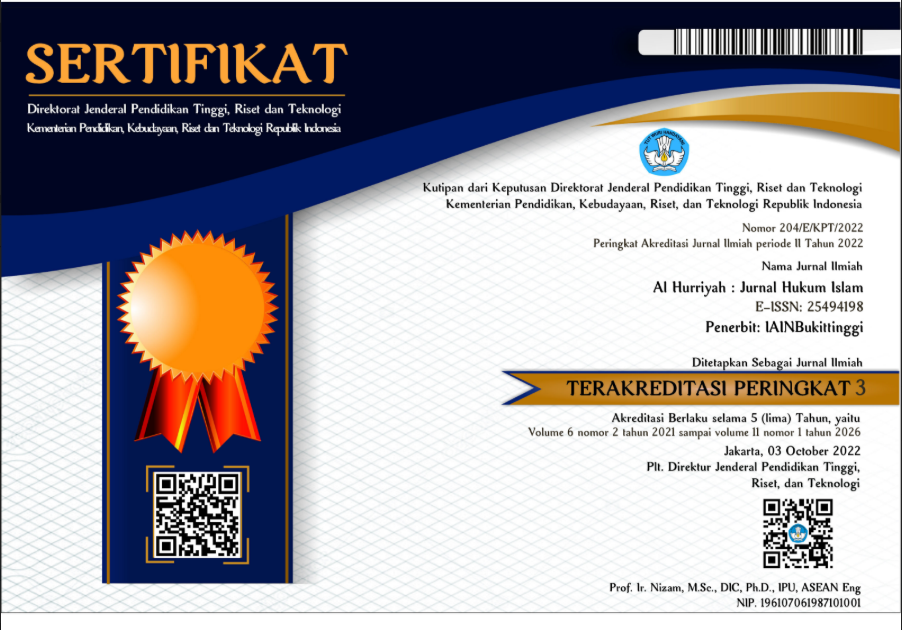PEMBERIAN UPAH PEMOTONGAN HEWAN QURBAN MENURUT HUKUM ISLAM (Studi Pada Masyarakat Tanjung Barulak Kab. Tanah Datar)
DOI:
https://doi.org/10.30983/alhurriyah.v3i2.740Abstract
Every year Muslims commemorate the feast of Idhul Adha. One form of celebration is done by sacrificing. Sacrifice is an amaliyah service whose provisions are regulated in Islam. Sacrifice according to etymology comes from Arabic, namely qaraba which means close. The word qurban is commensurate with the word al-udhiyyat which is defined as the name of an animal slaughtered on the Idhul Adha feast day and tasyrik days to draw closer to Allah. Whereas the term sacrifice means the slaughter of certain animals with the intention of drawing closer to Allah SWT, which is performed on the feast of Idhul Adha or in the days of Tasyrik which is the 11th, 12th and 13th of Dhulhijah. However, in Indonesia the implementation of slaughtering sacrificial animals in each region is carried out differently. Especially giving wages for slaughtering sacrificial animals. This article uses the analytical content method for the syllables' arguments and also uses the field research method, which is to gather information in the field related to the wages of slaughtering sacrificial animal sacrifices that occur in the middle of the community, especially the Tanjung Barulak district. Tanah Datar. The implementation of slaughtering sacrificial animals in the middle of the community is carried out differently. This is because this is a tradition that has been passed down for generations, both wages given in the form of meat, head, feet or parts of sacrificial animals are a reward for people who cut or clean sacrificial animals. The wages were still given but did not take from the sacrificial animal and then replaced the wages in the form of money taken or requested and collected from the sacrificial participants.
Â
References
DAFTAR PUSTAKA
Abdul Aziz Dahlan, Ensiklopedi Hukum Islam, 2003, Jakarta: PT Ichtiar Baru van hoeve, , Cet. 1, Jilid. 6
Abdurrahman Al- Jaziri, Fiqh Empat Mazhab, 2002, terjemahan Chatibul Umam dan Abu Hurairah, judul asli “Al-Fiqh ‘Ala Al-Madzabih Al-Arba’ah, Jakarta: Darul Ulum Pres, Jilid. 4
Abû ‘Abd Allâh Muhammad ibn Ismâ’îl ibn Ibrâhîm ibn al-Mughirat ibn Bardizbat Al-Bukhârî al-Ju’fî, Shahîh Al-Bukhârî, Dikutip dari al-Maktabah al-Syâmilah al-Ishdâr al-Tsânî Versi 2.11.
Abû al-Husayn Muslim ibn al-Hajjaj al-Qusyayri al-Naysaburi, Shahih Muslim Dikutip dari al-Maktabah al-Syâmilah al-Ishdâr al-Tsânî Versi 2.11
Amir Syarifuddin, 2001, Ushul Fiqh (jilid dua), Jakarta PT. Logos Wacana Ilmu,
Dendy Sugono, dkk, 1994, Kamus Besar Bahasa Indonesia,Jakarta: Balai Pustaka,
Imam Muhaddist Abi Abdullah Muhammad Bin Zaid al-Qoswaini, Sunan Ibnu Majah Dikutip dari al-Maktabah al-Syâmilah al-Ishdâr al-Tsânî Versi 2.11
Jaih Mubarak, 2003, Fiqh Kontemporer (Dalam Bidang Peternakan),Bandung, CV. Putaka Setia,
Muhammad ‘Uwaidah, Kamil, 2008, Fiqih Wanita, terjemahan M. Abdul Ghaffar e.m, judul asli “ Al-Jami’ Fii Fighi An-Nisaâ€,(Jakarta: Pustaka Al-Kautsar, Cet, II,
Muhammad Ibrahim Jannati, Fiqh Perbandingan Lima Mazhab, 2007, terjemahan Ibnu Alwi Bafaqih, dkk, judul asli, “Durus fi al-Fiqh al-Muqaranâ€, (Jakarta: Cahaya, , Cet. 1,
Muhammad Jawad Mughiyah, 2011, fiqih lima mazhab, terjemahan musykur A.B. dkk, judul asli “Al-Fiqh ‘ala al-madzabih al-khamsahâ€, Jakarta: Lentera, , Cet. 27,
Nana Syaodih Sukmadinata, Metode Penelitian Pendidikan, (Bandung: PT. Remaja Rosdakarya, 2009),
Sa’di Abu Habieb, Ensiklopedi Ijmak, 2006, terjemahan M. Sahal Machfudz dan A. Mustofa Bisri, (Jakarta: PT. Pustaka Firdaus, Cet. IV
Sayyid Quthb, 1984, al-‘Adalah al-Ijtima’iyyah fil Islam (tarjamah).Bandung, Pustaka,
Sayyid Sabiq, 2006, Fiqih Sunnah, Jakarta Pena pundi aksara
www.Almanhaj.or.id
Downloads
Published
How to Cite
Issue
Section
Citation Check
License
Authors who publish with this journal agree to the following terms:
- Authors retain copyright and grant the journal right of first publication with the work simultaneously licensed under a Creative Commons Attribution-ShareAlike 4.0 International License that allows others to share the work with an acknowledgment of the work's authorship and initial publication in this journal.
- Authors are able to enter into separate, additional contractual arrangements for the non-exclusive distribution of the journal's published version of the work (e.g., post it to an institutional repository or publish it in a book), with an acknowledgment of its initial publication in this journal.
- Authors are permitted and encouraged to post their work online (e.g., in institutional repositories or on their website) prior to and during the submission process, as it can lead to productive exchanges, as well as earlier and greater citation of published work (See The Effect of Open Access).





